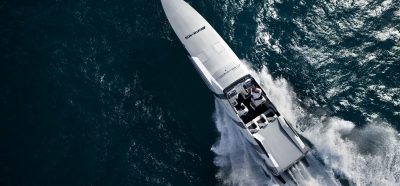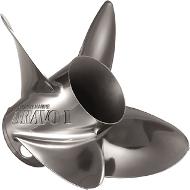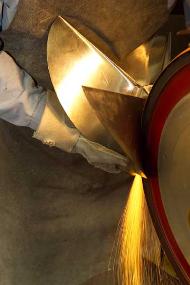
Propeller Information & Demo Prop Program
PRO BOATS IS A MERCURY MARINE DEMO PROP DEALER.
DEMO PROP PROGRAM IS WILLCALL AT STORE ONLY.
NO DEMO RACING PROPELLERS AVAILABLE.
Test a new propeller style before buying. See if there’s a better prop style for your boating demands!
INDEX:
1) AVAILABLE DEMO PROPELLERS
2) DEMO PROP PROGRAM
3) BASIC PROP TESTS
4) MERCURY PROPELLER MODELS
5) WHAT YOU NEED TO KNOW ABOUT PROPELLERS
6) PROPELLER REPAIR PRICES
7) PROP SLIP INFORMATION & CALCULATOR
1) AVAILABLE DEMO PROPELLERS
- Bravo-1 (4-Blade stainless steel) – 22P RH, 24P RH & 24P LH, 26P RH, 28P RH
- Enertia (3-Blade stainless steel) – 17P-RH & 17P-LH, 19P-RH & 19P-LH, 21P-RH & 21P-LH
- FURY (3-Blade stainless steel) – 24P-RH, 25P-RH, 26P-RH
- High Five (5-Blade stainless steel) – 19P-RH, 21P-RH, 23P-RH
- Mirage ( 3-Blade stainless steel) – 15P-RH & 15P-LH, 17P-RH, 23P-RH, 25P-RH
- Revolution-4 (4-Blade stainless steel) – 17P RH & 17P LH, 19P RH & 19P LH, 21P RH, 23P RH, 25P RH
- Trophy Plus (4-Blade stainless steel) – 21P RH, 23P RH, 24P RH, 25P RH, 26P RH, 27P RH
2) DEMO PROP PROGRAM
DEMO PROP PROGRAM IS WILLCALL AT STORE ONLY.
- Demo prop program requires deposit equal to price of propeller.
- You can test a variety of propellers and sizes; one propeller at a time.
- Once you have found the correct propeller for your needs, we will provide you with the new propeller.
- If a demo propeller shows damage, including nicked or grazed blade edges then the standard repair rate will be charged.
- If you do not purchase a propeller from PRO BOATS, a $60.00 service charge will be accessed and remainder of deposit will be refunded.
3) BASIC PROP TESTS
Whether you are looking at a prop for top speed, wakeboard /skiing or general boating;
two things are important with all applications:
- #1 PERIOD is WOT (engine RPM at wide open throttle) most engines have a 400 to 500RPM window at maximum RPM. Example: Power Band @ WOT = 4500 to 5000RPM; this means, engine requires @ WOT 4500RPM minimum when boat has a full load and a maximum RPM of 5000 with a minimum load ( 1 to 2 people and less than a half tank of fuel).
Wide open throttle maximum RPM range must be able to be reached with any propeller used under any application. - Get boat up on Plane Time: How fast can the boat get up on plane. This especially important for skiing and wakeboarding.
TESTS
NOTE: Load boat @ 2-persons maximum and ½ tank or less of fuel.
- On-Plane test: What RPM does engine rev-up to before boat starts moving?
- On-Plane test: How many seconds to get on-plane:
- NOTE: Do two tests of each, one throttling fast from idle to WOT and one rolling on throttle to ¾+ throttle position.
- Wide Open Throttle test: What RPM does engine have @ WOT?
- NOTE: Run maximum RPM for at least 10 seconds. Set drive trim, trim tabs for maximum boat lift to give maximum RPM and boat speed.
- 1/4 throttle or 2500RPM to WOT test:
- Does boat accelerate easily?
- Does prop slip/break loose (RPM goes up fast then stops)?
- Easy turns test: Take easy turns at ½ throttle:
- How does boat handle?
- Does prop spin / break loose?
 4) MERCURY PROPELLER MODELS
4) MERCURY PROPELLER MODELS
To purchase Propellers you can; Call us at 888-861-6757 or 909-599-0531
E-Mail thru our Contact Us page
Note: S.S. = Stainless Steel / RH = Right Hand / LH = Left Hand
- BLACK MAX (3-Blade Aluminum) 6 thru 16 Pitch RH 17-19-21-23-25 Pitch RH & LH
- BRAVO-1 (4-Blade S.S.) 22-24-26-28-30-32-34-36 Pitch RH & LH
- BRAVO-1 LAB FINISH (4-Blade S.S.) 22-24-25-26-27-28-29-30-31-32 33-34-35-36-37 Pitch RH & LH
- BRAVO-1 Vented LAB FINISH (4-Blade S.S.) 22-23-24-25-26-27-28 29-30-32-34-36 Pitch RH & LH (hub kit not included)
- BRAVO-1FS PRO FINISH (4-Blade S.S.) 22-23-24-25-26-27-28-29-30 31 RH & LH (hub kit not included)
- BRAVO-1XS PRO FINISH (4-Blade S.S.) 22-23-24-25-26-27-28-29-30 31 RH (hub kit not included)
- BRAVO-2 (3-Blade S.S.) 11-13-15-17-19-21-23-25 Pitch RH & LH
- BRAVO-2 (3-Blade Aluminum) 11-13-15-17-19-21-23-25 Pitch RH & LH
- BRAVO-3 (4-Blade S.S.Front & 3-Blade S.S. Rear Sold Seperately) 19-20-21-22.5-24-26-28 Pitch RH & LH in Matte or High Polish Finish
- BRAVO-3 Diesel (4-Blade S.S.Front & 3-Blade S.S. Rear Sold Separately) 21-23-25-27 Pitch RH & LH
- BRAVO-3 XR PRO FINISH (4-Blade S.S.Front & 3-Blade S.S. Rear Sold Separately) 21-22-23-24-25-26-27-28 Pitch RH & LH
- ENERTIA (3-Blade S.S.) 11-13-14-15-16-17-18-19-20-21-22 Pitch RH 11-13-14-15-17-19-21 Pitch LH
- FURY (3-Blade S.S.) 24-25-26-27 Pitch RH
- HIGH FIVE (5-Blade S.S.) 17-19-21-23-25 Pitch RH
- LASER II (3-Blade S.S.) 19-20-21-22-24-26 Pitch RH
- MIRAGE PLUS (3-Blade S.S.) 13-15-17-18-19-21-23-25-27 Pitch RH 15-17-18-19-21-23-25-27 Pitch LH
- MIRAGE PLUS LAB FINISH (3-Blade S.S.) 23-25-27-29 Pitch RH & LH
- REVOLUTION-4 (4-Blade S.S.) 15-17-19-21-23-25 Pitch RH & LH
- REVOLUTION-4 LAB FINISH (4-Blade S.S.) 19-21-23-25 Pitch RH & LH (hub kit not included)
- SPITFIRE (4-Blade Aluminum) 9.5-10-11-12-13-14-15-17-19-21-23 Pitch RH
- TEMPEST PLUS (3-Blade S.S.) 17-19-21-23-25-26-27-29 Pitch RH & LH
- TROPHY PLUS (4-Blade S.S.) 17-19-21-23-24-25-26-27-28 Pitch RH
- TROPHY SPORT (4-Blade S.S.) 12-13-14-15 Pitch RH
- VENGEANCE (3-Blade S.S.) 9-9.5-10-11-12-13-14-15-16-17-18-19-21-23 Pitch RH 17-19-21-23 Pitch LH
- VENSURA (4-Blade S.S.) 17-19-21-23 Pitch RH & LH
- ZEUS H-SERIES (5-Blade S.S. Front & 4-Blade S.S. Rear Sold Seperately)
- H6-H7-H8-H9-H10-H11-H12-H13-H14-H15-H16-H17 Pitch RH & LH
- ZEUS Z-SERIES (4-Blade S.S.Front & 3-Blade S.S. Rear Sold Seperately)
- Z6-Z7-Z8-Z9-Z10-Z11-Z12-Z13-Z14-Z15-Z16-Z17-Z18-Z19 Pitch RH & LH
- ZEUS M-SERIES (5-Blade S.S.Front & 4-Blade S.S. Rear Sold Seperately) M0-M1-M2-M3-M4-M5-M6-M7-M8-M9-M10-M11-M12-M13-M14 Pitch RH & LH
MERCURY RACE PROPELLERS
- BRAVO-3 XR PRO FINISH (4-Blade S.S.Front & 3-Blade S.S. Rear Sold Separately) 21-23-24-25-26-27-28 Pitch RH & LH
- MAXIMUS-Standard Hub (5-Blade S.S.) 24-26-28-30-32-34 Pitch RH & LH 1-1/4″ S.S. Hub Kit
- MAXIMUS-Long Tube LAB Finish (5-Blade S.S.) 23-24-25-26-27-28-29-30-31-32 33-34-35 Pitch RH & LH with 1-1/4″ Heavy Duty S.S. Hub Kit
- MAXIMUS-Short Tube LAB Finish (5-Blade S.S.) 23-24-25-26-27-28-29-30-31-32-33-34-35 Pitch RH & LH with 1-1/4″ Heavy Duty S.S. Hub Kit
- LIGHTNING E.T. LAB Finish (3-Blade S.S.) 22P RH 24-26-28-30-32 Pitch RH & LH
- PRO E.T. LAB Finish (4-Blade S.S.) 26-28-30-32 Pitch RH & 32P LH
- PRO E.T. POLISH Finish (4-Blade S.S.) 26-28-30-32 Pitch RH & 32P LH
- PRO MAX LAB Finish (4-Blade S.S.) 24-26-28-30-32 Pitch RH
- PRO MAX LAB Finish (4-Blade S.S.) 23-24-25-26-27-28-29-30-31-32 Pitch RH
- CHOPPER II (3-Blade S.S.) 10-3/8″x18 Pitch RH 10 Spline & 13 Spline
- CHOPPER II (3-Blade S.S.) 22 RH 24-26-28-30-32 Pitch RH & LH (Hub Kit not included)
- CLEAVER (3-Blade S.S.) 11″-11.5″-12″Dia / 14-16-18-20-22 Pitch RH
- CLEAVER PRO Finish (3-Blade S.S.) 15″Dia / 28-30-32-34 Pitch RH & LH
- CLEAVER LAB Finish (3-Blade S.S.) 15″Dia /28-30-32-34 Pitch RH & LH
- CLEAVER LAB Finish (3-Blade S.S.) 14.5″Dia / 28-30-32-34 Pitch RH & LH
- CLEAVER STOCK or LAB Finish (4-Blade S.S.) 14.5″-15″Dia / 26-28-30-32-34 Pitch RH & LH
 5) WHAT YOU NEED TO KNOW ABOUT PROPELLERS
5) WHAT YOU NEED TO KNOW ABOUT PROPELLERS
One of the most important aspects of boat performance is the propeller. The Propeller PITCH must be correct for your boat to get up to it’s full potential; no matter what size of engine or kind of boat.
Pitch is theoretical distance, in inches a propeller moves forward per one revolution. A 24-inch pitch prop should move forward 24 inches with each 360 degree turn @ 100% efficiency. Slippage is the amount of forward movement lost per revolution.
The goal in selecting prop pitch is to be able to run the engine at, or near manufacturer’s recommended maximum RPM when at full throttle with a typical load in the boat, trimmed up for speed.
With a pitch too high (over propped) the engine won’t reach maximum RPM, slow to get up on plane and have sluggish performance.
With a pitch too low (under propped) the boat will jump up on plane quickly (or worst case, spin the prop and over rev the engine while slowly coming up to plane), accelerates quickly, breaks the prop loose in turns, causing the engine to rev-up and slip the prop and at wide open throttle (WOT), exceed maximum RPM.
Neither condition is healthy for the engine, fuel economy and especially performance.
At WOT a increase or decrease of each inch of pitch is equal to 150-200 RPM; decrease pitch by one = increase in maximum RPM 150-200. Increase pitch by one = decrease in maximum RPM 150-200.
Once a “base line” prop pitch is established for WOT, the next step is to choose a prop that will best handle your boating style and requirements.
6) PROPELLER REPAIR PRICES
All propellers are trued and balanced prior to being hand polished to a mirror finish.
(Polishing excluded on aluminum)
Pricing includes most repairs. If repair requires excessive welding or major reshaping, additional charges may apply.
You will be notified prior to repair.
STAINLESS STEEL THROUGH HUB PROPELLERS
- Three Blades: $195.00 Dia. over 16″: $230.00
- Four Blades: $220.00 Dia. over 16″: $250.00
- Five Blades: $240.00 Dia. over 16″: $270.00
- Six Blades: $270.00 Dia. over 16″: $340.00
STAINLESS STEEL OVER HUB PROPELLERS
- Three Blades: $170.00
- Four Blades: $195.00
- Five Blades: $215.00
STAINLESS STEEL & STEEL V DRIVE PROPELLERS
- Two Blade Rework/Repair: $165.00
- Three Blade Rework/Repair: $190.00
ALUMINUM PROPELLERS
- Three Blades: $100.00
- Four Blades: $120.00
BRASS/BRONZE NIBRAL PROPELLERS
- Three Blades: $145.00
- Four Blades: $165.00
- Over 17″ Diameter: $240.00 & UP
RACE PREP LAB SERVICE
- Call for Pricing
7) PROP SLIP INFORMATION & CALCULATOR
- Use the online Propeller Slip Calculator
Because it sounds like a negative, “slip” might be the most misunderstood of all propeller terms. But slip is actually essential to propeller function.
Propeller slip is the difference between the actual distance the prop travels forward through the water versus the distance it should theoretically travel based on the prop blades’ angle of attack. The theoretical travel is determined by the prop pitch. A prop with a 21-inch pitch, for example, would travel 21 inches with one revolution through a soft solid. Think about a screw turning into a piece of wood. However, in the real world and in real water, the propeller does not act like a screw turning through wood. There will be a certain amount of slip, which is actually necessary.
This sounds inefficient. It seems that zero slip would certainly be ideal. However, slip is not a measure of propeller efficiency, and without some slip the prop could not move the boat forward at all.
To understand why, let’s back up and define the term “angle of attack.” One way to understand angle of attack is to think about an airplane wing. If that wing is a symmetrical airfoil moving through the air horizontally – a zero-degree angle of attack – air will pass symmetrically above and below the wing, resulting in equal pressure above and below the wing. No lift is generated to carry the weight of the plane. If we add some angle of attack by tilting the leading edge of the wing up, lift is generated. There will be negative pressure above the wing and positive pressure below the wing. You can experience the same effect by holding your hand out the window of a moving car. If you tilt your hand up, you feel lift.
The function of a boat propeller blade is like that of the airplane wing. If the propeller blade has no angle of attack, there is no slip, but also no positive or negative pressure around the blades. Propeller blades with some angle of attack create negative (lower or pulling) pressure on one side of the blade and positive (higher or pushing) pressure on the other side of the blade. The pressure difference creates lift at right angles to the blade surface, which both lifts the boat and thrusts it forward.
That angle of attack also results in some slip. Without some slip, there’s no thrust. Creating the desired range of slip is one of the key challenges facing a propeller engineer, and there are a number of ways this can be accomplished within all of the other design parameters (blade diameter, blade shape and area, blade rake and cup) the engineer needs to consider.
Calculating slip can be useful when diagnosing an issue with a setup. Calculated propeller slip within the range of 5% to 25% is typical and acceptable. If slip is greater than 25%, there is likely an issue with the propeller. It could be damaged or just wildly wrong for the boat-and-engine combination. Or, it could be ventilating because the outdrive or outboard motor is mounted too high on the transom. The online Mercury Racing Prop Slip Calculator makes it easy to calculate prop slip. Professional race teams and performance boat owners seeking to maximize speed can commission custom propellers designed for a very specific boat-and-engine combination. A custom propeller can operate much more efficiently and with better performance than any mass-produced propeller, but at significant financial cost.
Boat speed is really the best indicator of prop efficiency. The prop that makes your boat run the fastest is going to be most efficient at wide-open throttle, regardless of its slip. However, a prop that delivers the best top speed might not work well at cruising speed, when some props might keep the bow high and make for an awkward cruise.
Every motor/engine/prop combination will perform differently, and the ideal way to find the best combination for your boat is simply to try different propellers. You can also talk to your Mercury authorized dealer about your boat-and-engine combination, because your dealer has likely seen what works best on similar boats. They can help you find a good prop to begin testing.
Just remember that a little slip is essential for propelling your boat – and your fun on the water.
Reprinted from Mercury Dockline Blog May 19,2021
©2018–2020 PRO BOATS This website and its contents are the property of PRO BOATS. Reproduction in whole or in part without permission is prohibited.
